snow chains LEXUS ES350 2022 Owners Manual
[x] Cancel search | Manufacturer: LEXUS, Model Year: 2022, Model line: ES350, Model: LEXUS ES350 2022Pages: 468, PDF Size: 26.96 MB
Page 181 of 468
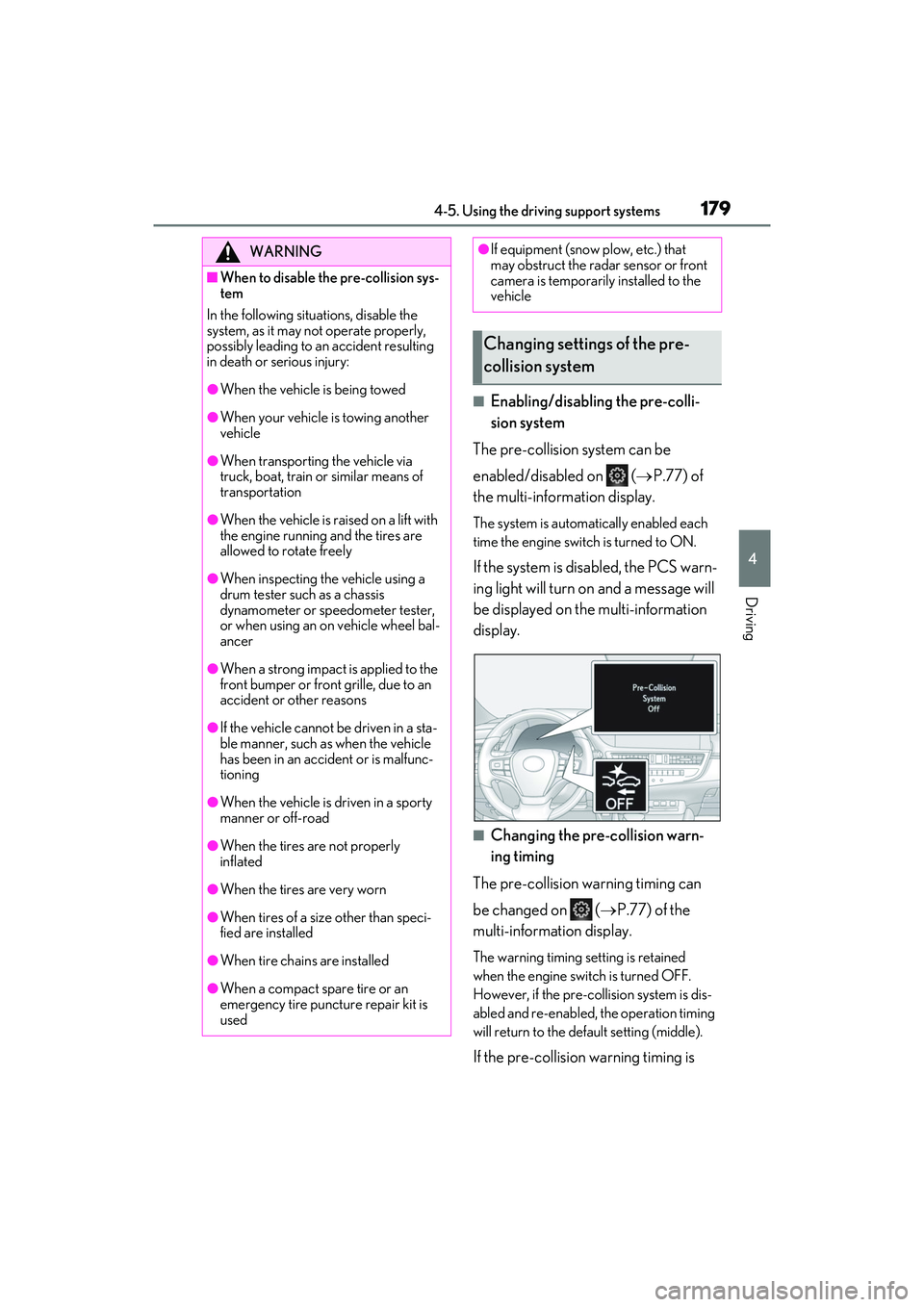
1794-5. Using the driving support systems
4
Driving
Ō¢ĀEnabling/disabling the pre-colli-
sion system
The pre-collision system can be
enabled/disabled on ( ’é«P.77) of
the multi-information display.
The system is automatically enabled each
time the engine switch is turned to ON.
If the system is disabled, the PCS warn-
ing light will turn on and a message will
be displayed on the multi-information
display.
Ō¢ĀChanging the pre-collision warn-
ing timing
The pre-collision warning timing can
be changed on ( ’é«P.77) of the
multi-information display.
The warning timing setting is retained
when the engine switch is turned OFF.
However, if the pre-collision system is dis-
abled and re-enabled, the operation timing
will return to the default setting (middle).
If the pre-collision warning timing is
WARNING
Ō¢ĀWhen to disable the pre-collision sys-
tem
In the following situations, disable the
system, as it may not operate properly,
possibly leading to an accident resulting
in death or serious injury:
ŌŚÅWhen the vehicle is being towed
ŌŚÅWhen your vehicle is towing another
vehicle
ŌŚÅWhen transporting the vehicle via
truck, boat, train or similar means of
transportation
ŌŚÅWhen the vehicle is raised on a lift with
the engine running and the tires are
allowed to rotate freely
ŌŚÅWhen inspecting the vehicle using a
drum tester such as a chassis
dynamometer or speedometer tester,
or when using an on vehicle wheel bal-
ancer
ŌŚÅWhen a strong impact is applied to the
front bumper or front grille, due to an
accident or other reasons
ŌŚÅIf the vehicle cannot be driven in a sta-
ble manner, such as when the vehicle
has been in an accident or is malfunc-
tioning
ŌŚÅWhen the vehicle is driven in a sporty
manner or off-road
ŌŚÅWhen the tires are not properly
inflated
ŌŚÅWhen the tires are very worn
ŌŚÅWhen tires of a size other than speci-
fied are installed
ŌŚÅWhen tire chains are installed
ŌŚÅWhen a compact spare tire or an
emergency tire puncture repair kit is
used
ŌŚÅIf equipment (snow plow, etc.) that
may obstruct the radar sensor or front
camera is temporarily installed to the
vehicle
Changing settings of the pre-
collision system
Page 189 of 468
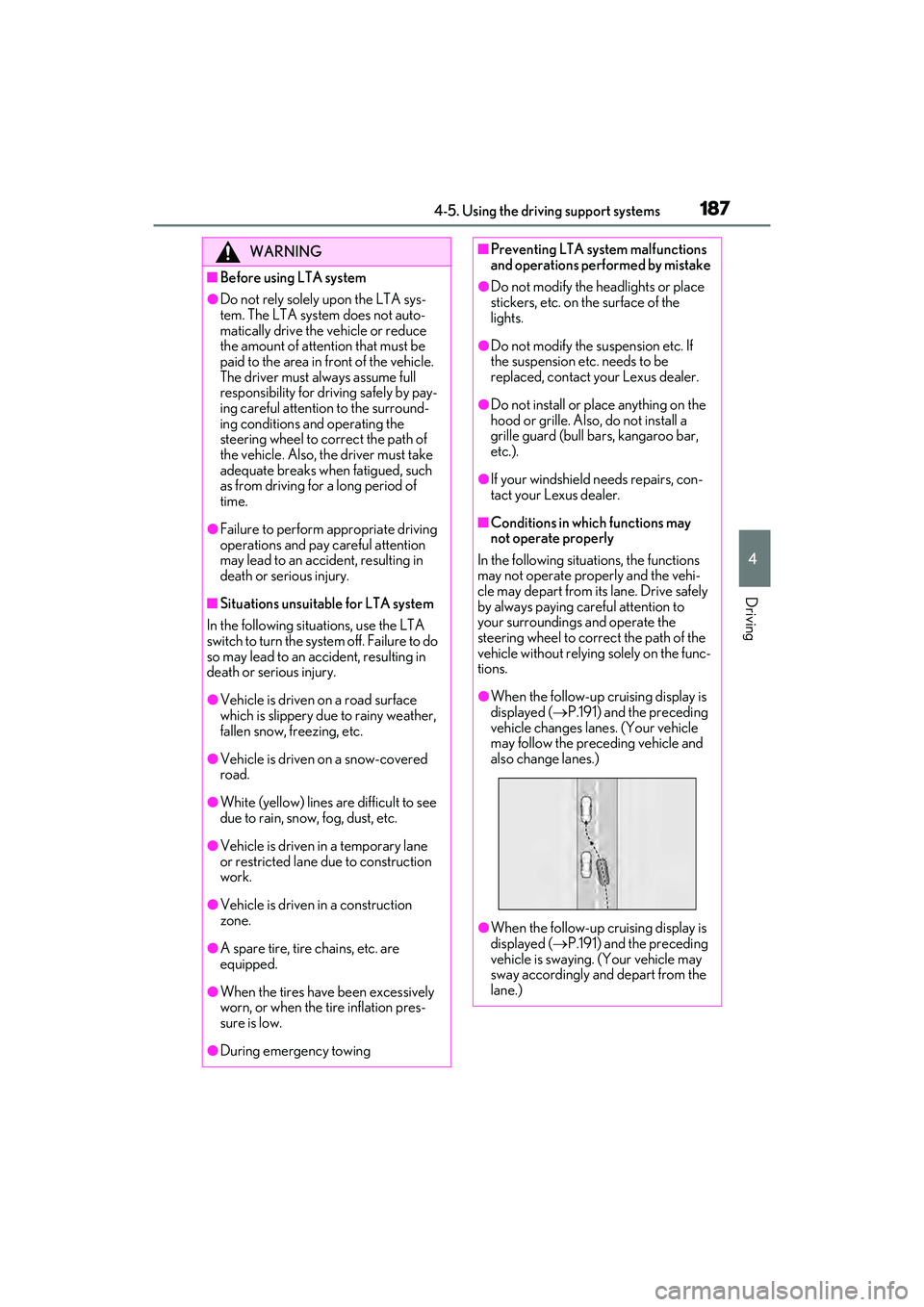
1874-5. Using the driving support systems
4
Driving
WARNING
Ō¢ĀBefore using LTA system
ŌŚÅDo not rely solely upon the LTA sys-
tem. The LTA system does not auto-
matically drive the vehicle or reduce
the amount of attention that must be
paid to the area in front of the vehicle.
The driver must always assume full
responsibility for driving safely by pay-
ing careful attention to the surround-
ing conditions and operating the
steering wheel to correct the path of
the vehicle. Also, the driver must take
adequate breaks when fatigued, such
as from driving for a long period of
time.
ŌŚÅFailure to perform appropriate driving
operations and pay careful attention
may lead to an accident, resulting in
death or serious injury.
Ō¢ĀSituations unsuitable for LTA system
In the following situations, use the LTA
switch to turn the system off. Failure to do
so may lead to an acc ident, resulting in
death or serious injury.
ŌŚÅVehicle is driven on a road surface
which is slippery due to rainy weather,
fallen snow, freezing, etc.
ŌŚÅVehicle is driven on a snow-covered
road.
ŌŚÅWhite (yellow) lines are difficult to see
due to rain, snow, fog, dust, etc.
ŌŚÅVehicle is driven in a temporary lane
or restricted lane due to construction
work.
ŌŚÅVehicle is driven in a construction
zone.
ŌŚÅA spare tire, tire chains, etc. are
equipped.
ŌŚÅWhen the tires have been excessively
worn, or when the tire inflation pres-
sure is low.
ŌŚÅDuring emergency towing
Ō¢ĀPreventing LTA system malfunctions
and operations performed by mistake
ŌŚÅDo not modify the headlights or place
stickers, etc. on the surface of the
lights.
ŌŚÅDo not modify the suspension etc. If
the suspension etc. needs to be
replaced, contact your Lexus dealer.
ŌŚÅDo not install or place anything on the
hood or grille. Also, do not install a
grille guard (bull bars, kangaroo bar,
etc.).
ŌŚÅIf your windshield needs repairs, con-
tact your Lexus dealer.
Ō¢ĀConditions in which functions may
not operate properly
In the following situations, the functions
may not operate properly and the vehi-
cle may depart from its lane. Drive safely
by always paying careful attention to
your surroundings and operate the
steering wheel to correct the path of the
vehicle without relying solely on the func-
tions.
ŌŚÅWhen the follow-up cruising display is
displayed ( ’é«P.191) and the preceding
vehicle changes lanes. (Your vehicle
may follow the preceding vehicle and
also change lanes.)
ŌŚÅWhen the follow-up cruising display is
displayed ( ’é«P.191) and the preceding
vehicle is swaying. (Your vehicle may
sway accordingly and depart from the
lane.)
Page 221 of 468
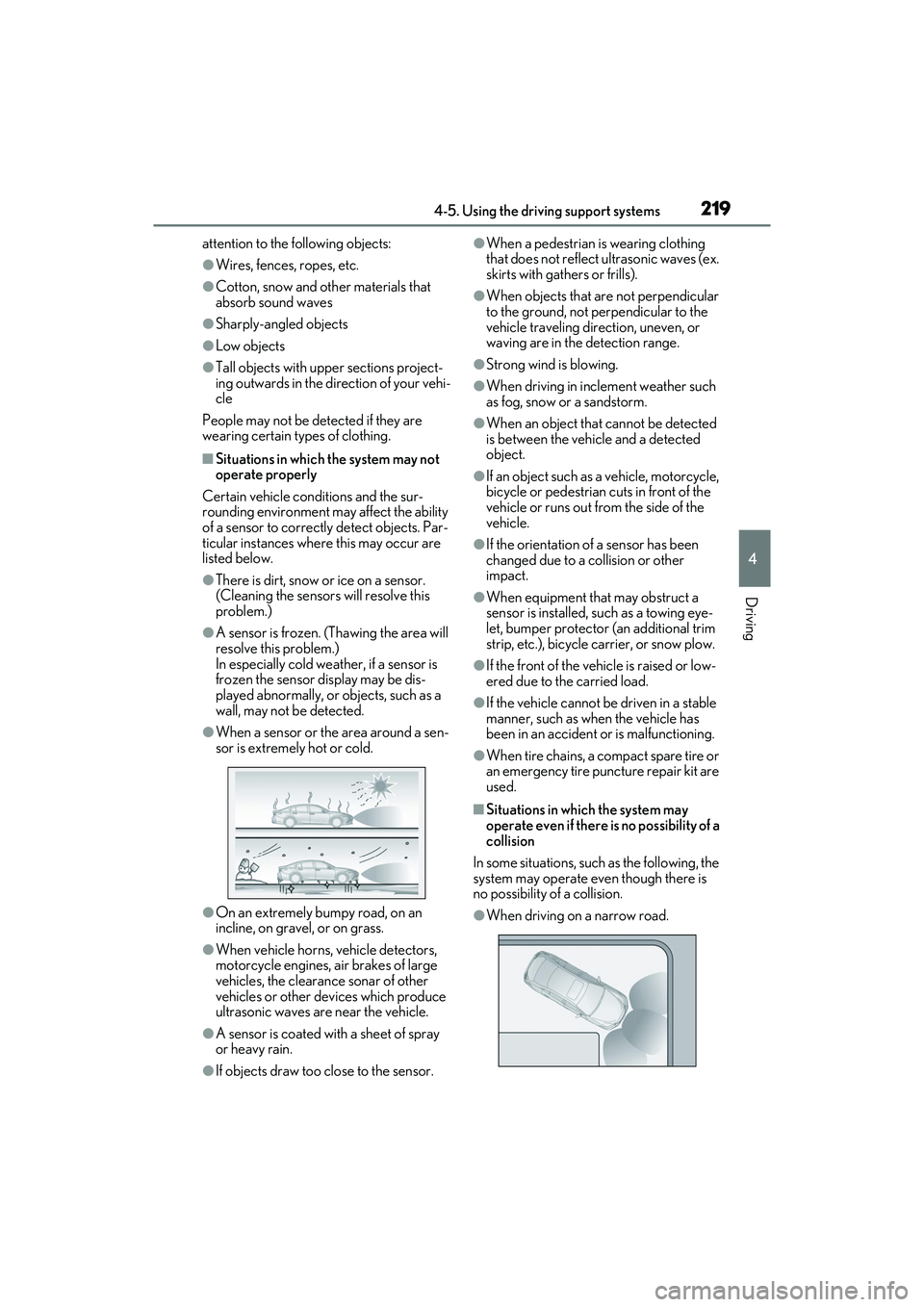
2194-5. Using the driving support systems
4
Driving
attention to the following objects:
ŌŚÅWires, fences, ropes, etc.
ŌŚÅCotton, snow and other materials that
absorb sound waves
ŌŚÅSharply-angled objects
ŌŚÅLow objects
ŌŚÅTall objects with upper sections project-
ing outwards in the direction of your vehi-
cle
People may not be detected if they are
wearing certain types of clothing.
Ō¢ĀSituations in which the system may not
operate properly
Certain vehicle conditions and the sur-
rounding environment may affect the ability
of a sensor to correctly detect objects. Par-
ticular instances where this may occur are
listed below.
ŌŚÅThere is dirt, snow or ice on a sensor.
(Cleaning the sensors will resolve this
problem.)
ŌŚÅA sensor is frozen. (Thawing the area will
resolve this problem.)
In especially cold weather, if a sensor is
frozen the sensor display may be dis-
played abnormally, or objects, such as a
wall, may not be detected.
ŌŚÅWhen a sensor or the area around a sen-
sor is extremely hot or cold.
ŌŚÅOn an extremely bumpy road, on an
incline, on gravel, or on grass.
ŌŚÅWhen vehicle horns, vehicle detectors,
motorcycle engines, air brakes of large
vehicles, the clearance sonar of other
vehicles or other devices which produce
ultrasonic waves are near the vehicle.
ŌŚÅA sensor is coated with a sheet of spray
or heavy rain.
ŌŚÅIf objects draw too close to the sensor.
ŌŚÅWhen a pedestrian is wearing clothing
that does not reflect ultrasonic waves (ex.
skirts with gathers or frills).
ŌŚÅWhen objects that are not perpendicular
to the ground, not perpendicular to the
vehicle traveling direction, uneven, or
waving are in the detection range.
ŌŚÅStrong wind is blowing.
ŌŚÅWhen driving in inclement weather such
as fog, snow or a sandstorm.
ŌŚÅWhen an object that cannot be detected
is between the vehicle and a detected
object.
ŌŚÅIf an object such as a vehicle, motorcycle,
bicycle or pedestrian cuts in front of the
vehicle or runs out from the side of the
vehicle.
ŌŚÅIf the orientation of a sensor has been
changed due to a collision or other
impact.
ŌŚÅWhen equipment that may obstruct a
sensor is installed, such as a towing eye-
let, bumper protector (an additional trim
strip, etc.), bicycle carrier, or snow plow.
ŌŚÅIf the front of the vehicle is raised or low-
ered due to the carried load.
ŌŚÅIf the vehicle cannot be driven in a stable
manner, such as when the vehicle has
been in an accident or is malfunctioning.
ŌŚÅWhen tire chains, a compact spare tire or
an emergency tire puncture repair kit are
used.
Ō¢ĀSituations in which the system may
operate even if there is no possibility of a
collision
In some situations, such as the following, the
system may operate even though there is
no possibility of a collision.
ŌŚÅWhen driving on a narrow road.
Page 222 of 468
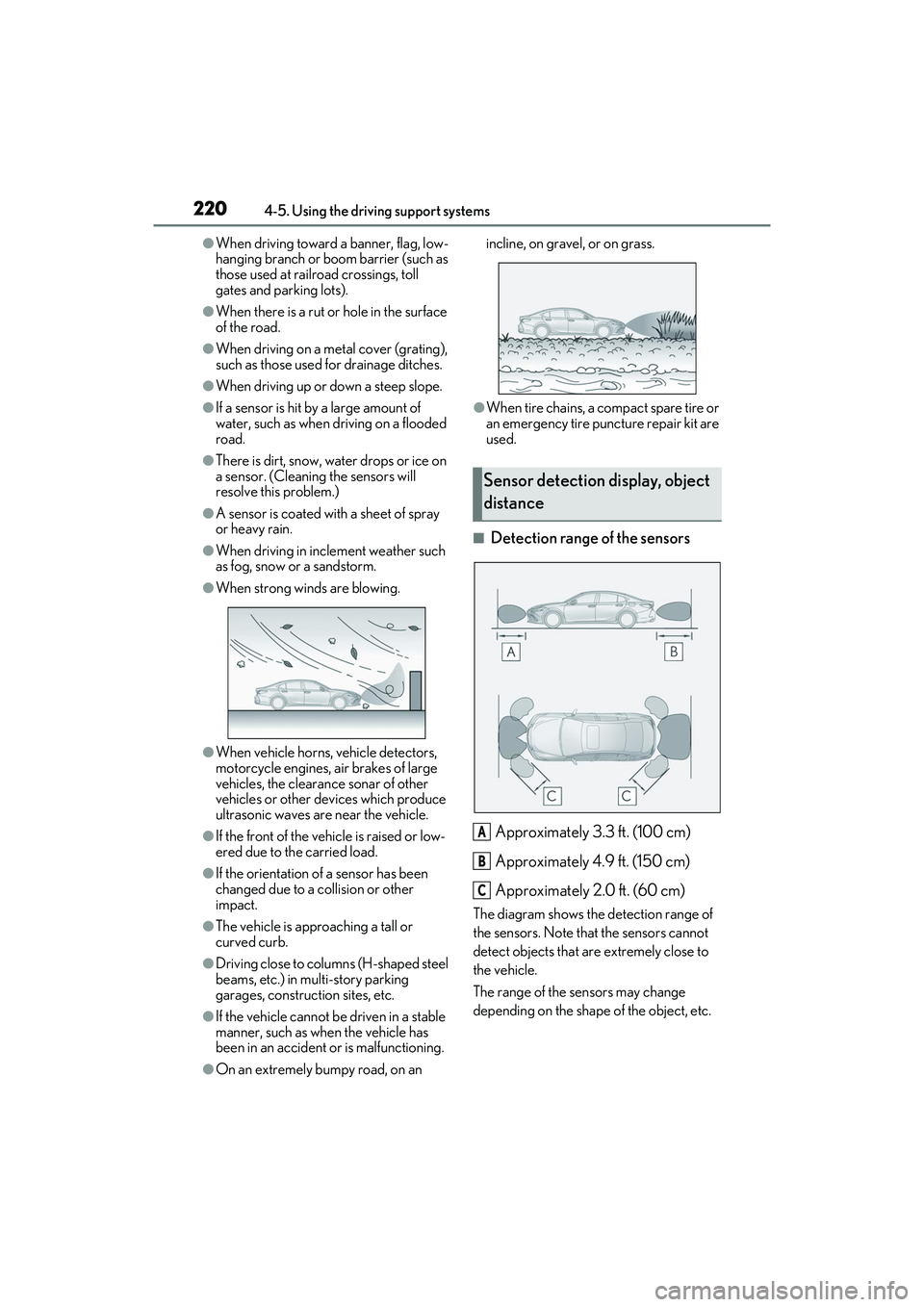
2204-5. Using the driving support systems
ŌŚÅWhen driving toward a banner, flag, low-
hanging branch or boom barrier (such as
those used at railroad crossings, toll
gates and parking lots).
ŌŚÅWhen there is a rut or hole in the surface
of the road.
ŌŚÅWhen driving on a metal cover (grating),
such as those used for drainage ditches.
ŌŚÅWhen driving up or down a steep slope.
ŌŚÅIf a sensor is hit by a large amount of
water, such as when driving on a flooded
road.
ŌŚÅThere is dirt, snow, water drops or ice on
a sensor. (Cleaning the sensors will
resolve this problem.)
ŌŚÅA sensor is coated with a sheet of spray
or heavy rain.
ŌŚÅWhen driving in inclement weather such
as fog, snow or a sandstorm.
ŌŚÅWhen strong winds are blowing.
ŌŚÅWhen vehicle horns, vehicle detectors,
motorcycle engines, air brakes of large
vehicles, the clearance sonar of other
vehicles or other devices which produce
ultrasonic waves are near the vehicle.
ŌŚÅIf the front of the vehicle is raised or low-
ered due to the carried load.
ŌŚÅIf the orientation of a sensor has been
changed due to a collision or other
impact.
ŌŚÅThe vehicle is approaching a tall or
curved curb.
ŌŚÅDriving close to columns (H-shaped steel
beams, etc.) in multi-story parking
garages, construction sites, etc.
ŌŚÅIf the vehicle cannot be driven in a stable
manner, such as when the vehicle has
been in an accident or is malfunctioning.
ŌŚÅOn an extremely bumpy road, on an incline, on gravel, or on grass.
ŌŚÅWhen tire chains, a compact spare tire or
an emergency tire puncture repair kit are
used.
Ō¢ĀDetection range of the sensors
Approximately 3.3 ft. (100 cm)
Approximately 4.9 ft. (150 cm)
Approximately 2.0 ft. (60 cm)
The diagram shows the detection range of
the sensors. Note that the sensors cannot
detect objects that are extremely close to
the vehicle.
The range of the sensors may change
depending on the shape of the object, etc.
Sensor detection di splay, object
distance
A
B
C
Page 233 of 468
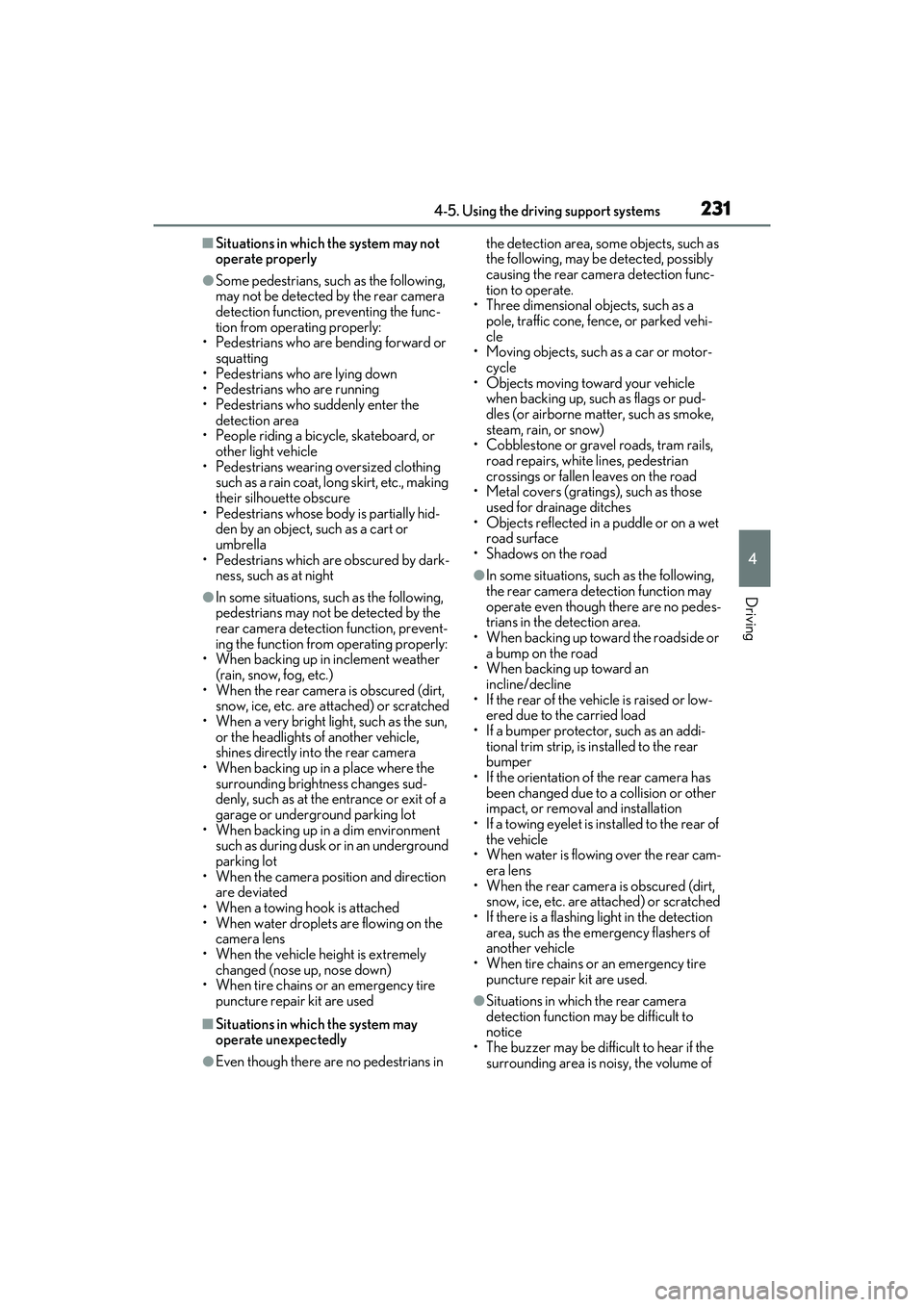
2314-5. Using the driving support systems
4
Driving
Ō¢ĀSituations in which the system may not
operate properly
ŌŚÅSome pedestrians, such as the following,
may not be detected by the rear camera
detection function, preventing the func-
tion from operating properly:
ŌĆó Pedestrians who are bending forward or squatting
ŌĆó Pedestrians who are lying down
ŌĆó Pedestrians who are running
ŌĆó Pedestrians who suddenly enter the detection area
ŌĆó People riding a bicycle, skateboard, or other light vehicle
ŌĆó Pedestrians wearing oversized clothing such as a rain coat, long skirt, etc., making
their silhouette obscure
ŌĆó Pedestrians whose body is partially hid- den by an object, such as a cart or
umbrella
ŌĆó Pedestrians which are obscured by dark- ness, such as at night
ŌŚÅIn some situations, such as the following,
pedestrians may not be detected by the
rear camera detection function, prevent-
ing the function from operating properly:
ŌĆó When backing up in inclement weather (rain, snow, fog, etc.)
ŌĆó When the rear camera is obscured (dirt, snow, ice, etc. are attached) or scratched
ŌĆó When a very bright light, such as the sun,
or the headlights of another vehicle,
shines directly into the rear camera
ŌĆó When backing up in a place where the
surrounding brightness changes sud-
denly, such as at the entrance or exit of a
garage or underground parking lot
ŌĆó When backing up in a dim environment such as during dusk or in an underground
parking lot
ŌĆó When the camera position and direction are deviated
ŌĆó When a towing hook is attached
ŌĆó When water droplets are flowing on the camera lens
ŌĆó When the vehicle height is extremely
changed (nose up, nose down)
ŌĆó When tire chains or an emergency tire
puncture repair kit are used
Ō¢ĀSituations in which the system may
operate unexpectedly
ŌŚÅEven though there are no pedestrians in the detection area, some objects, such as
the following, may be detected, possibly
causing the rear camera detection func-
tion to operate.
ŌĆó Three dimensional objects, such as a pole, traffic cone, fence, or parked vehi-
cle
ŌĆó Moving objects, such as a car or motor- cycle
ŌĆó Objects moving toward your vehicle when backing up, such as flags or pud-
dles (or airborne matter, such as smoke,
steam, rain, or snow)
ŌĆó Cobblestone or gravel roads, tram rails, road repairs, white lines, pedestrian
crossings or fallen leaves on the road
ŌĆó Metal covers (gratings), such as those used for drainage ditches
ŌĆó Objects reflected in a puddle or on a wet road surface
ŌĆóShadows on the road
ŌŚÅIn some situations, such as the following,
the rear camera detection function may
operate even though there are no pedes-
trians in the detection area.
ŌĆó When backing up toward the roadside or
a bump on the road
ŌĆó When backing up toward an incline/decline
ŌĆó If the rear of the vehicle is raised or low- ered due to the carried load
ŌĆó If a bumper protector, such as an addi-
tional trim strip, is installed to the rear
bumper
ŌĆó If the orientation of the rear camera has
been changed due to a collision or other
impact, or removal and installation
ŌĆó If a towing eyelet is installed to the rear of
the vehicle
ŌĆó When water is flowing over the rear cam- era lens
ŌĆó When the rear camera is obscured (dirt, snow, ice, etc. are attached) or scratched
ŌĆó If there is a flashing light in the detection
area, such as the emergency flashers of
another vehicle
ŌĆó When tire chains or an emergency tire puncture repair kit are used.
ŌŚÅSituations in which the rear camera
detection function may be difficult to
notice
ŌĆó The buzzer may be difficult to hear if the surrounding area is noisy, the volume of
Page 235 of 468
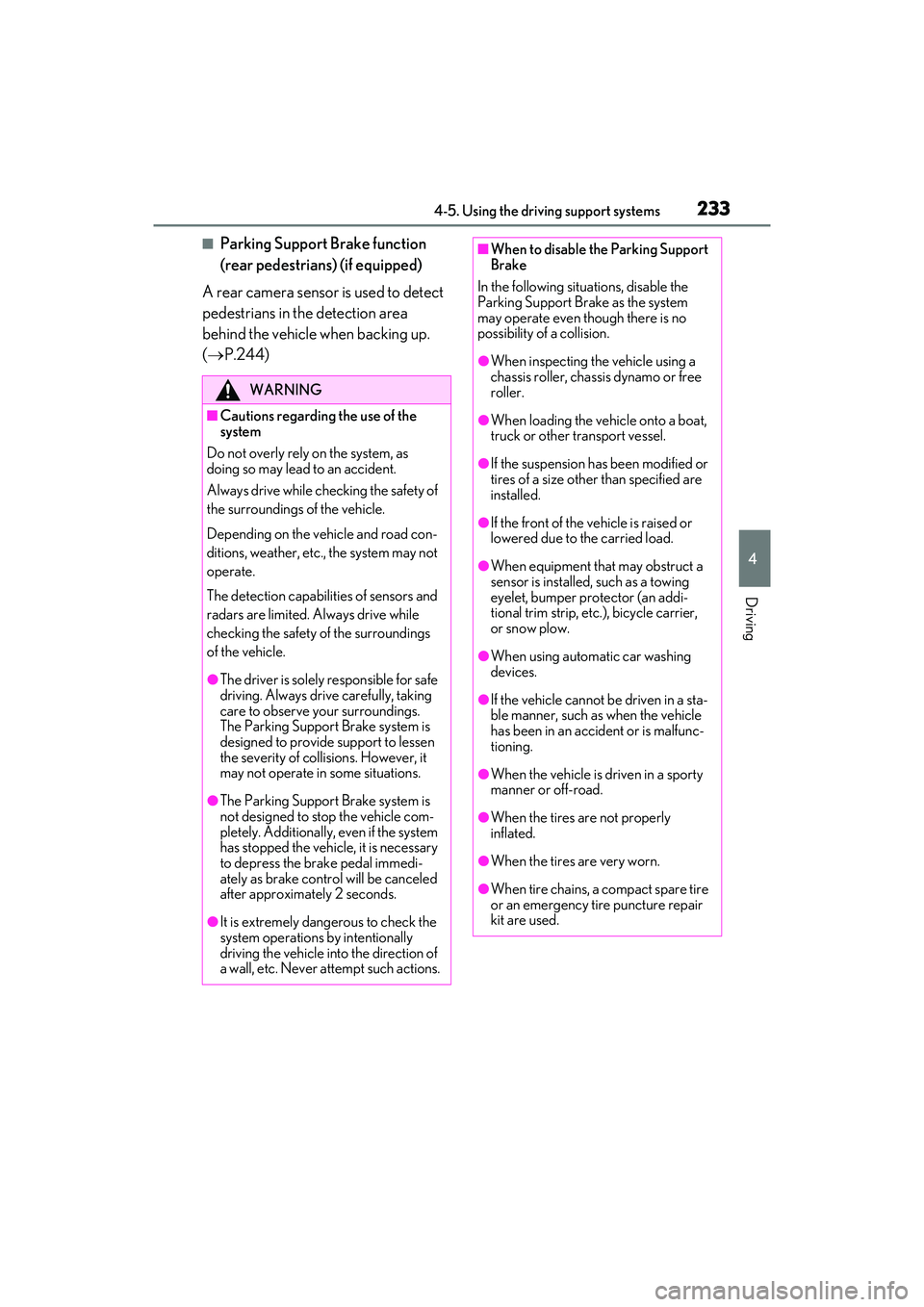
2334-5. Using the driving support systems
4
Driving
Ō¢ĀParking Support Brake function
(rear pedestrians) (if equipped)
A rear camera sensor is used to detect
pedestrians in the detection area
behind the vehicle when backing up.
( ’é« P.244)
WARNING
Ō¢ĀCautions regarding the use of the
system
Do not overly rely on the system, as
doing so may lead to an accident.
Always drive while checking the safety of
the surroundings of the vehicle.
Depending on the vehicle and road con-
ditions, weather, etc., the system may not
operate.
The detection capabilities of sensors and
radars are limited. Always drive while
checking the safety of the surroundings
of the vehicle.
ŌŚÅThe driver is solely responsible for safe
driving. Always drive carefully, taking
care to observe your surroundings.
The Parking Support Brake system is
designed to provide support to lessen
the severity of collisions. However, it
may not operate in some situations.
ŌŚÅThe Parking Support Brake system is
not designed to stop the vehicle com-
pletely. Additionally, even if the system
has stopped the vehicle, it is necessary
to depress the brake pedal immedi-
ately as brake control will be canceled
after approximately 2 seconds.
ŌŚÅIt is extremely dangerous to check the
system operations by intentionally
driving the vehicle in to the direction of
a wall, etc. Never attempt such actions.
Ō¢ĀWhen to disable the Parking Support
Brake
In the following situations, disable the
Parking Support Brake as the system
may operate even though there is no
possibility of a collision.
ŌŚÅWhen inspecting the vehicle using a
chassis roller, chassis dynamo or free
roller.
ŌŚÅWhen loading the vehicle onto a boat,
truck or other transport vessel.
ŌŚÅIf the suspension has been modified or
tires of a size other than specified are
installed.
ŌŚÅIf the front of the vehicle is raised or
lowered due to the carried load.
ŌŚÅWhen equipment that may obstruct a
sensor is installed, such as a towing
eyelet, bumper protector (an addi-
tional trim strip, etc.), bicycle carrier,
or snow plow.
ŌŚÅWhen using automatic car washing
devices.
ŌŚÅIf the vehicle cannot be driven in a sta-
ble manner, such as when the vehicle
has been in an accident or is malfunc-
tioning.
ŌŚÅWhen the vehicle is driven in a sporty
manner or off-road.
ŌŚÅWhen the tires are not properly
inflated.
ŌŚÅWhen the tires are very worn.
ŌŚÅWhen tire chains, a compact spare tire
or an emergency tire puncture repair
kit are used.
Page 251 of 468
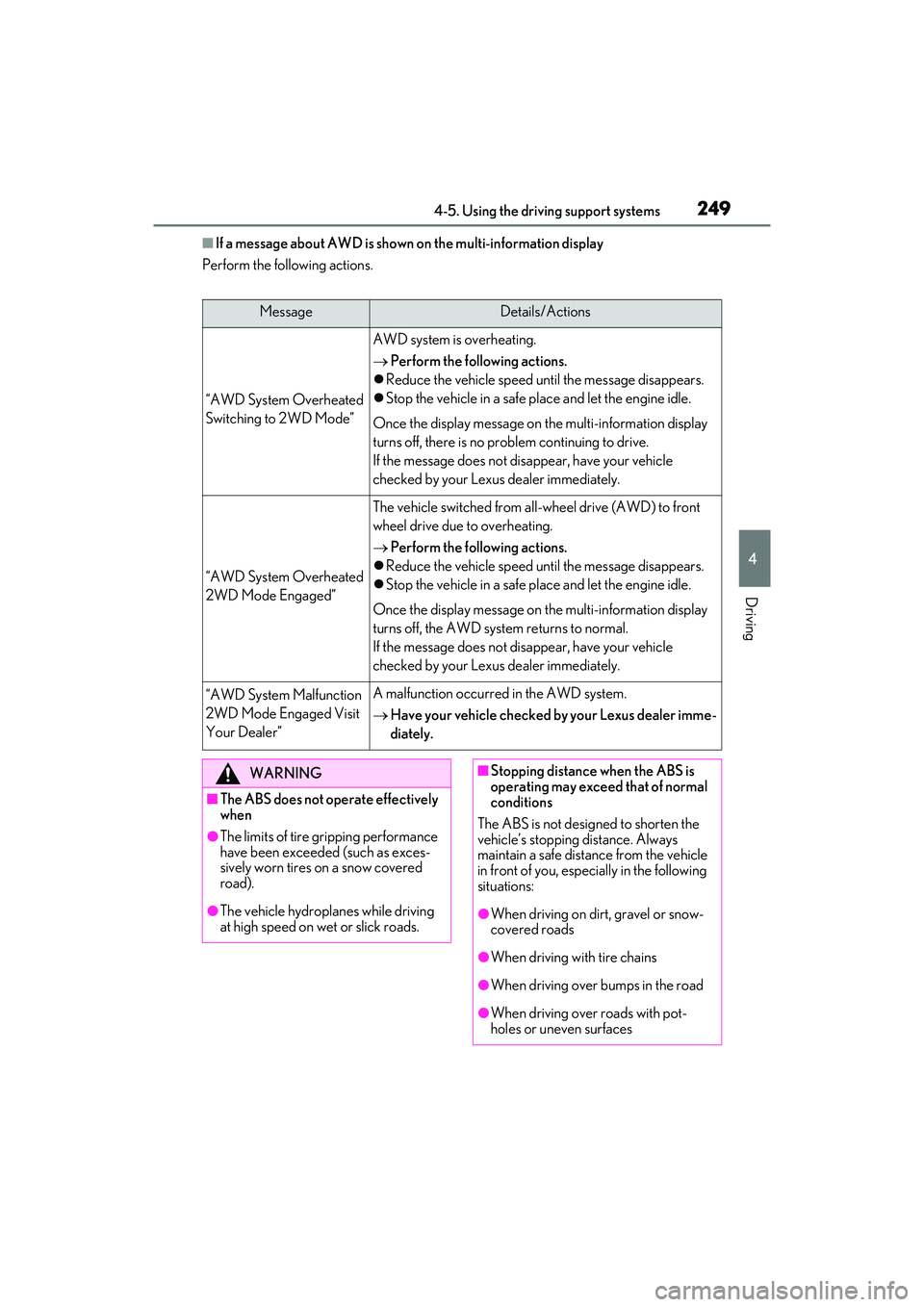
2494-5. Using the driving support systems
4
Driving
Ō¢ĀIf a message about AWD is shown on the multi-information display
Perform the following actions.
MessageDetails/Actions
ŌĆ£AWD System Overheated
Switching to 2WD ModeŌĆØ
AWD system is overheating.
’é« Perform the following actions.
’ü¼ Reduce the vehicle speed until the message disappears.
’ü¼ Stop the vehicle in a safe place and let the engine idle.
Once the display message on the multi-information display
turns off, there is no problem continuing to drive.
If the message does not disappear, have your vehicle
checked by your Lexus dealer immediately.
ŌĆ£AWD System Overheated
2WD Mode EngagedŌĆØ
The vehicle switched from all-wheel drive (AWD) to front
wheel drive due to overheating.
’é« Perform the following actions.
’ü¼ Reduce the vehicle speed until the message disappears.
’ü¼ Stop the vehicle in a safe place and let the engine idle.
Once the display message on the multi-information display
turns off, the AWD system returns to normal.
If the message does not disappear, have your vehicle
checked by your Lexus dealer immediately.
ŌĆ£AWD System Malfunction
2WD Mode Engaged Visit
Your DealerŌĆØA malfunction occurred in the AWD system.
’é« Have your vehicle checked by your Lexus dealer imme-
diately.
WARNING
Ō¢ĀThe ABS does not operate effectively
when
ŌŚÅThe limits of tire gripping performance
have been exceeded (such as exces-
sively worn tires on a snow covered
road).
ŌŚÅThe vehicle hydroplanes while driving
at high speed on wet or slick roads.
Ō¢ĀStopping distance when the ABS is
operating may exceed that of normal
conditions
The ABS is not designed to shorten the
vehicleŌĆÖs stopping distance. Always
maintain a safe distance from the vehicle
in front of you, especially in the following
situations:
ŌŚÅWhen driving on dirt, gravel or snow-
covered roads
ŌŚÅWhen driving with tire chains
ŌŚÅWhen driving over bumps in the road
ŌŚÅWhen driving over roads with pot-
holes or uneven surfaces
Page 253 of 468
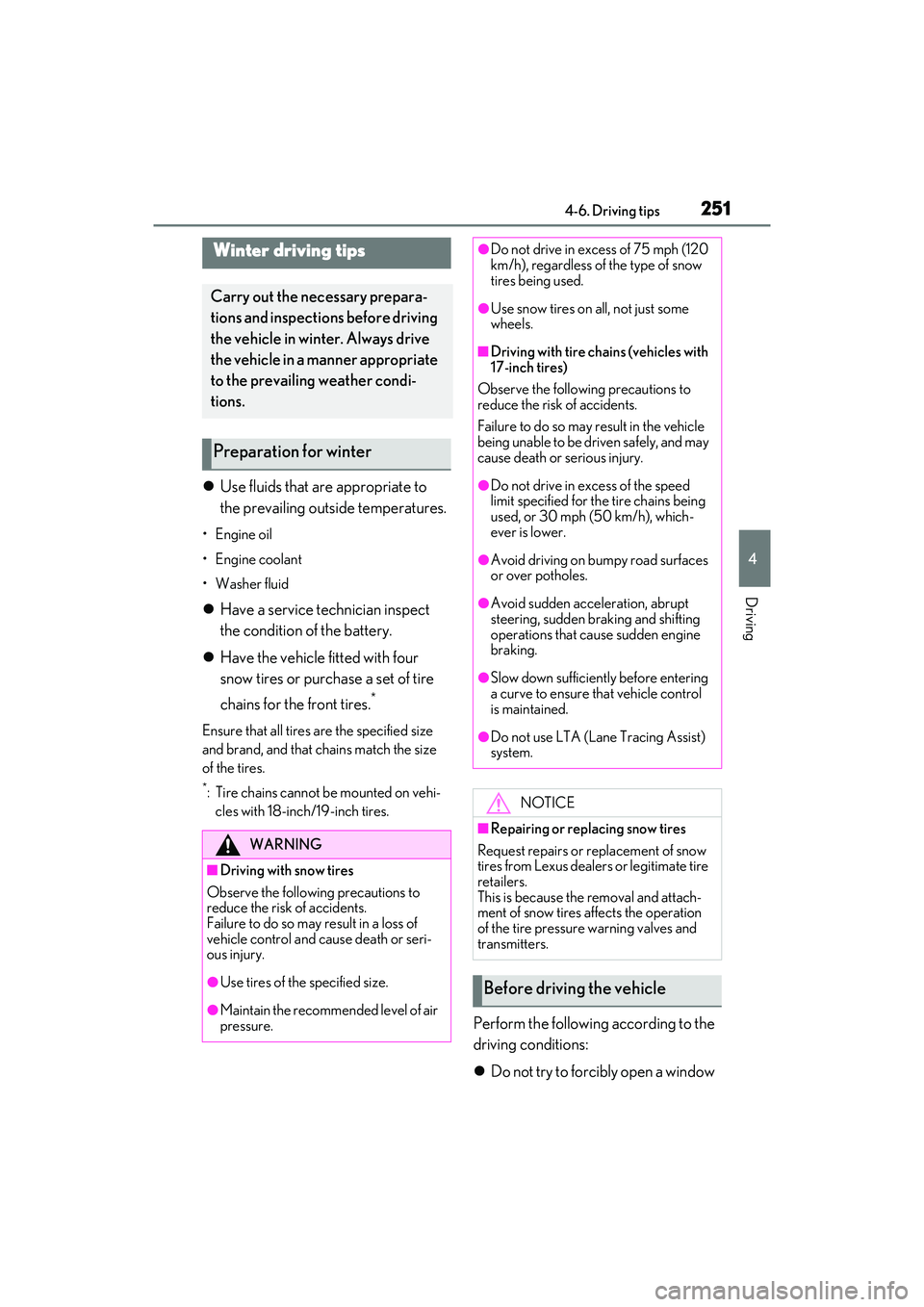
2514-6. Driving tips
4
Driving
4-6.Driving tips
’ü¼Use fluids that are appropriate to
the prevailing outside temperatures.
ŌĆóEngine oil
ŌĆó Engine coolant
ŌĆóWasher fluid
’ü¼Have a service technician inspect
the condition of the battery.
’ü¼ Have the vehicle fitted with four
snow tires or purchase a set of tire
chains for the front tires.
*
Ensure that all tires are the specified size
and brand, and that chains match the size
of the tires.
*: Tire chains cannot be mounted on vehi-
cles with 18-inch/19-inch tires.
Perform the following according to the
driving conditions:
’ü¼ Do not try to forcibly open a window
Winter driving tips
Carry out the necessary prepara-
tions and inspection s before driving
the vehicle in winter. Always drive
the vehicle in a manner appropriate
to the prevailing weather condi-
tions.
Preparation for winter
WARNING
Ō¢ĀDriving with snow tires
Observe the following precautions to
reduce the risk of accidents.
Failure to do so may result in a loss of
vehicle control and cause death or seri-
ous injury.
ŌŚÅUse tires of the specified size.
ŌŚÅMaintain the recommended level of air
pressure.
ŌŚÅDo not drive in excess of 75 mph (120
km/h), regardless of the type of snow
tires being used.
ŌŚÅUse snow tires on all, not just some
wheels.
Ō¢ĀDriving with tire chains (vehicles with
17-inch tires)
Observe the following precautions to
reduce the risk of accidents.
Failure to do so may result in the vehicle
being unable to be driven safely, and may
cause death or serious injury.
ŌŚÅDo not drive in excess of the speed
limit specified for the tire chains being
used, or 30 mph (50 km/h), which-
ever is lower.
ŌŚÅAvoid driving on bumpy road surfaces
or over potholes.
ŌŚÅAvoid sudden acceleration, abrupt
steering, sudden braking and shifting
operations that cause sudden engine
braking.
ŌŚÅSlow down sufficiently before entering
a curve to ensure that vehicle control
is maintained.
ŌŚÅDo not use LTA (Lane Tracing Assist)
system.
NOTICE
Ō¢ĀRepairing or replacing snow tires
Request repairs or replacement of snow
tires from Lexus dealers or legitimate tire
retailers.
This is because the removal and attach-
ment of snow tires affects the operation
of the tire pressure warning valves and
transmitters.
Before driving the vehicle
Page 254 of 468
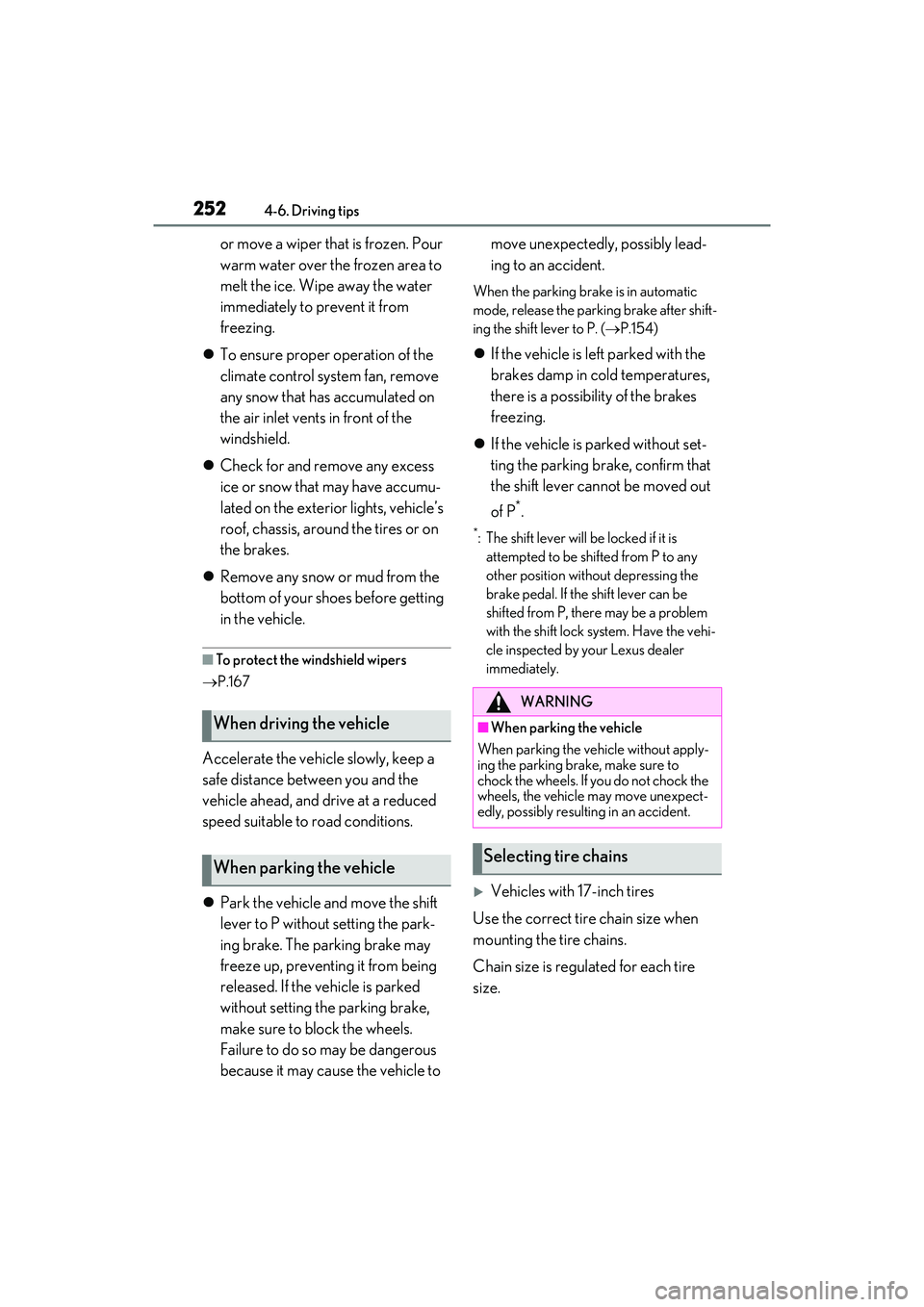
2524-6. Driving tips
or move a wiper that is frozen. Pour
warm water over the frozen area to
melt the ice. Wipe away the water
immediately to prevent it from
freezing.
’ü¼ To ensure proper operation of the
climate control system fan, remove
any snow that has accumulated on
the air inlet vents in front of the
windshield.
’ü¼ Check for and remove any excess
ice or snow that may have accumu-
lated on the exterior lights, vehicleŌĆÖs
roof, chassis, around the tires or on
the brakes.
’ü¼ Remove any snow or mud from the
bottom of your shoes before getting
in the vehicle.
Ō¢ĀTo protect the windshield wipers
’é« P.167
Accelerate the vehicle slowly, keep a
safe distance between you and the
vehicle ahead, and drive at a reduced
speed suitable to road conditions.
’ü¼ Park the vehicle and move the shift
lever to P without setting the park-
ing brake. The parking brake may
freeze up, preventing it from being
released. If the vehicle is parked
without setting the parking brake,
make sure to block the wheels.
Failure to do so may be dangerous
because it may cause the vehicle to move unexpectedly, possibly lead-
ing to an accident.
When the parking brake is in automatic
mode, release the parking brake after shift-
ing the shift lever to P. (
’é«P.154)
’ü¼ If the vehicle is left parked with the
brakes damp in cold temperatures,
there is a possibility of the brakes
freezing.
’ü¼ If the vehicle is parked without set-
ting the parking brake, confirm that
the shift lever cannot be moved out
of P
*.
*: The shift lever will be locked if it is
attempted to be shifted from P to any
other position without depressing the
brake pedal. If the shift lever can be
shifted from P, there may be a problem
with the shift lock system. Have the vehi-
cle inspected by your Lexus dealer
immediately.
’üĄVehicles with 17-inch tires
Use the correct tire chain size when
mounting the tire chains.
Chain size is regulated for each tire
size.
When driving the vehicle
When parking the vehicle
WARNING
Ō¢ĀWhen parking the vehicle
When parking the vehicle without apply-
ing the parking brake, make sure to
chock the wheels. If you do not chock the
wheels, the vehicle may move unexpect-
edly, possibly resulting in an accident.
Selecting tire chains
Page 255 of 468
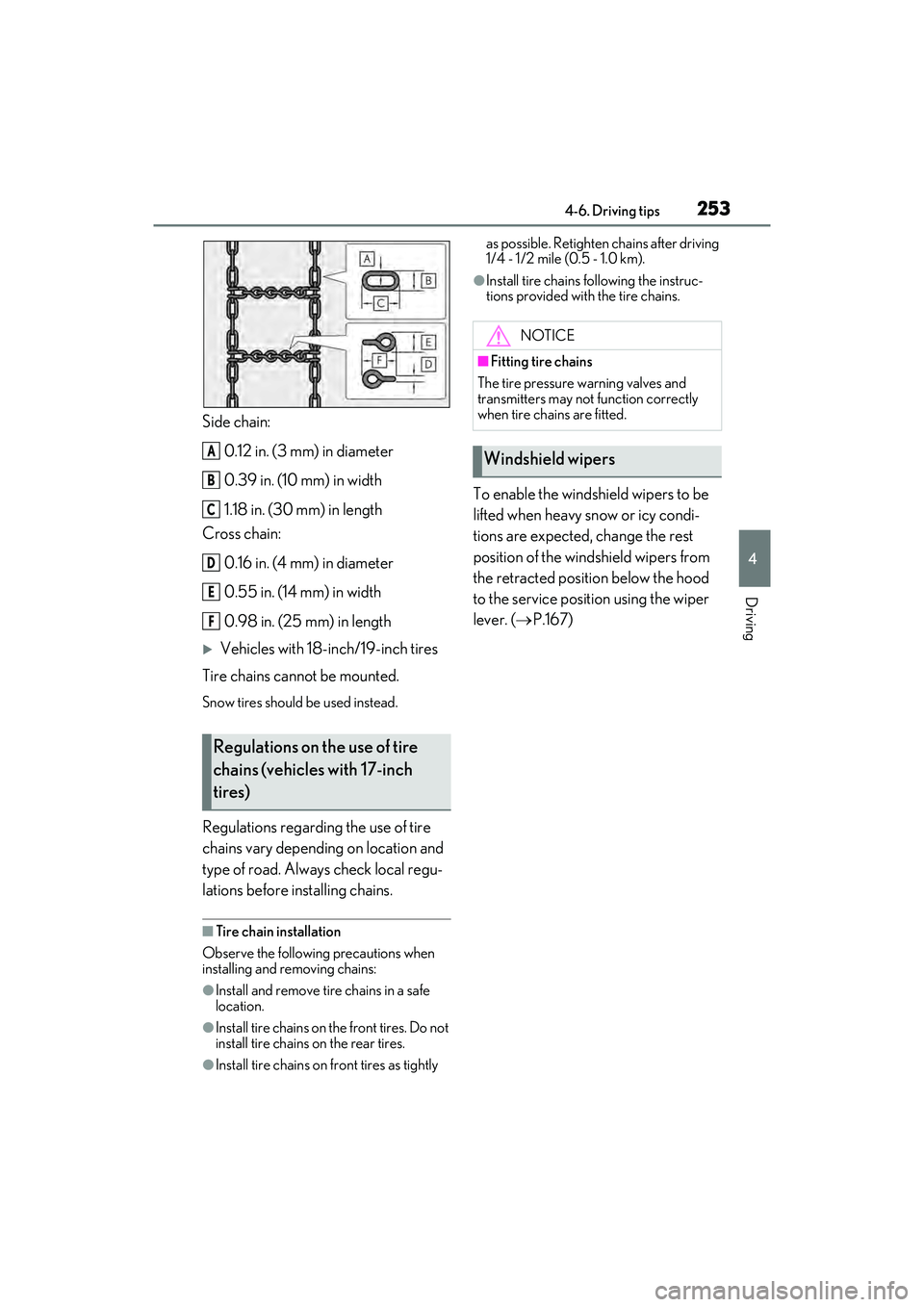
2534-6. Driving tips
4
Driving
Side chain:0.12 in. (3 mm) in diameter
0.39 in. (10 mm) in width
1.18 in. (30 mm) in length
Cross chain:
0.16 in. (4 mm) in diameter
0.55 in. (14 mm) in width
0.98 in. (25 mm) in length
’üĄVehicles with 18-inch/19-inch tires
Tire chains cannot be mounted.
Snow tires should be used instead.
Regulations regarding the use of tire
chains vary depending on location and
type of road. Always check local regu-
lations before installing chains.
Ō¢ĀTire chain installation
Observe the following precautions when
installing and re moving chains:
ŌŚÅInstall and remove tire chains in a safe
location.
ŌŚÅInstall tire chains on the front tires. Do not
install tire chains on the rear tires.
ŌŚÅInstall tire chains on front tires as tightly as possible. Retighten chains after driving
1/4 - 1/2 mile (0.5 - 1.0 km).
ŌŚÅInstall tire chains following the instruc-
tions provided with the tire chains.
To enable the windshield wipers to be
lifted when heavy snow or icy condi-
tions are expected, change the rest
position of the windshield wipers from
the retracted position below the hood
to the service position using the wiper
lever. (
’é«P.167)
Regulations on the use of tire
chains (vehicles with 17-inch
tires)
A
B
C
D
E
F
NOTICE
Ō¢ĀFitting tire chains
The tire pressure warning valves and
transmitters may not function correctly
when tire chains are fitted.
Windshield wipers